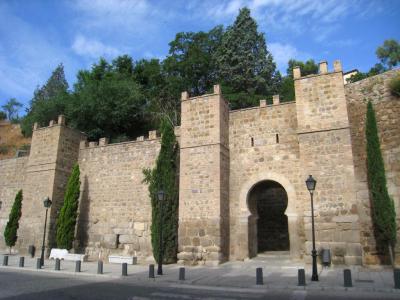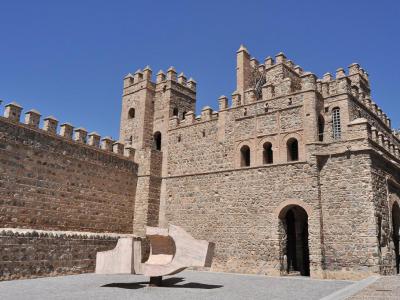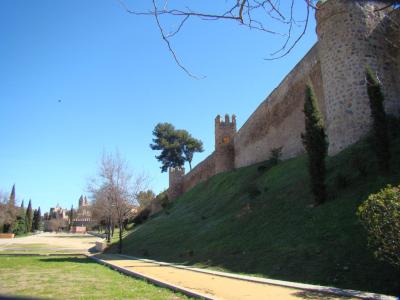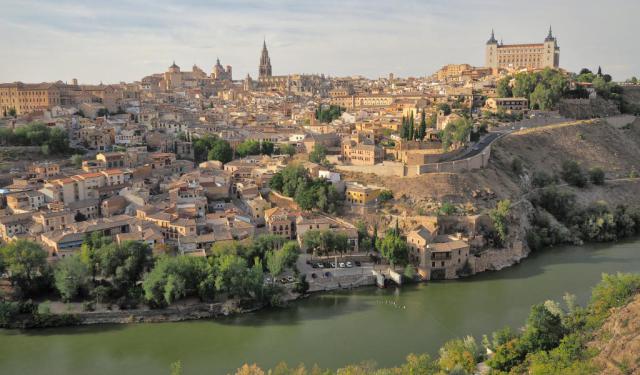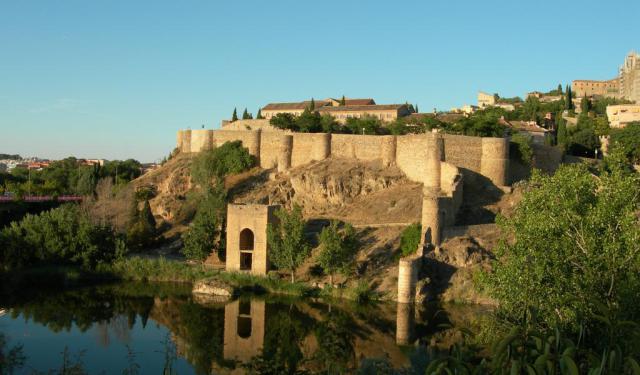
Toledo's Ancient Walls, Gates and Bridges (Self Guided), Toledo
Other than its signature “Toledo steel”, the Spanish city of Toledo is known for its historic architecture, particularly the ancient mammoth fortifications – a testament to the strength of the city that has maintained its borders for well over a thousand years.
Toledo's soaring walls were first built by the Romans in the 3rd century AD and then further expanded, over the following centuries, by the Visigoths, Moors, and Christians. Made up of a combination of stone and brick, these walls encircle the Old Town and extend for nearly 2.5 miles with an average height of 40 feet.
There are several gates along these walls, each with its own unique story and architecture. One of the most famous of them is the Puerta de Bisagra (Bisagra Gate), originally constructed by the Moors in the 10th century and then renovated in the 16th. The gate features a mix of Gothic and Mudéjar styles and is adorned with intricate carvings and decorations. Other notable gates include the Puerta del Sol (Sun Gate) and the Puerta de Alfonso VI (Alfonso VI Gate).
Toledo is also known for its ancient bridges, which cross the Tagus River and connect the city to the surrounding countryside. Among the most prominent here is the Puente de San Martin (San Martin Bridge), which dates back to the 14th century and is named after St. Martin of Tours. This stone bridge features three arches, with a central one spanning 40 meters. Another notable bridge is the Puente de Alcántara (Alcantara Bridge), which dates back to the Roman era and was rebuilt by the Moors in the 9th century.
Overall, the walls, gates, and bridges of Toledo offer a fascinating glimpse into the city's glorious past and today represent stand-alone attractions in their own right for anyone visiting the city. If you wish to take a self-guided walk along these landmarks without fear of getting lost, consider using the GPSmyCity app and enjoy yourself along the way!
Toledo's soaring walls were first built by the Romans in the 3rd century AD and then further expanded, over the following centuries, by the Visigoths, Moors, and Christians. Made up of a combination of stone and brick, these walls encircle the Old Town and extend for nearly 2.5 miles with an average height of 40 feet.
There are several gates along these walls, each with its own unique story and architecture. One of the most famous of them is the Puerta de Bisagra (Bisagra Gate), originally constructed by the Moors in the 10th century and then renovated in the 16th. The gate features a mix of Gothic and Mudéjar styles and is adorned with intricate carvings and decorations. Other notable gates include the Puerta del Sol (Sun Gate) and the Puerta de Alfonso VI (Alfonso VI Gate).
Toledo is also known for its ancient bridges, which cross the Tagus River and connect the city to the surrounding countryside. Among the most prominent here is the Puente de San Martin (San Martin Bridge), which dates back to the 14th century and is named after St. Martin of Tours. This stone bridge features three arches, with a central one spanning 40 meters. Another notable bridge is the Puente de Alcántara (Alcantara Bridge), which dates back to the Roman era and was rebuilt by the Moors in the 9th century.
Overall, the walls, gates, and bridges of Toledo offer a fascinating glimpse into the city's glorious past and today represent stand-alone attractions in their own right for anyone visiting the city. If you wish to take a self-guided walk along these landmarks without fear of getting lost, consider using the GPSmyCity app and enjoy yourself along the way!
How it works: Download the app "GPSmyCity: Walks in 1K+ Cities" from Apple App Store or Google Play Store to your mobile phone or tablet. The app turns your mobile device into a personal tour guide and its built-in GPS navigation functions guide you from one tour stop to next. The app works offline, so no data plan is needed when traveling abroad.
Toledo's Ancient Walls, Gates and Bridges Map
Guide Name: Toledo's Ancient Walls, Gates and Bridges
Guide Location: Spain » Toledo (See other walking tours in Toledo)
Guide Type: Self-guided Walking Tour (Sightseeing)
# of Attractions: 9
Tour Duration: 1 Hour(s)
Travel Distance: 2.1 Km or 1.3 Miles
Author: nataly
Sight(s) Featured in This Guide:
Guide Location: Spain » Toledo (See other walking tours in Toledo)
Guide Type: Self-guided Walking Tour (Sightseeing)
# of Attractions: 9
Tour Duration: 1 Hour(s)
Travel Distance: 2.1 Km or 1.3 Miles
Author: nataly
Sight(s) Featured in This Guide:
- Puente de Alcantara (Alcantara Bridge)
- Puerta de Alcántara (Alcantara Gate)
- Puerta del Sol (Sun Gate)
- Puerta Bab al-Mardum (Bab al-Mardum Gate)
- Puerta de Bisagra Nueva (New Hinged Door)
- Puerta de Alfonso VI (Alfonso VI Gate)
- Muralla de Toledo (City Walls of Toledo)
- Puerta del Cambron (Cambron Gate)
- Puente de San Martin (San Martin Bridge)
1) Puente de Alcantara (Alcantara Bridge)
The Alcantara Bridge is a historical landmark and an impressive feat of engineering located in Toledo. This ancient bridge spans the Tagus River and was built by the Romans after they founded the city. The name "Alcántara" is derived from the Arabic word "al-qanţarah," meaning "arch," which reflects the bridge's impressive architectural design.
Located at the foot of the Castillo de San Servando, the Puente de Alcántara was one of the few entrances for pilgrims into the city during the Middle Ages. It currently features two arches, but there is evidence that it had three arches when it was originally constructed. Over time, the bridge suffered damage and was rebuilt, with a third arch disappearing and being reduced to a gate with a horseshoe arch during the 10th century.
During the reign of Alfonso X of Castile, the bridge suffered serious damage and was rebuilt. The western tower, which still stands today, belongs to this period and was later decorated under the reign of the Catholic Monarchs, whose arms decorate its walls. The pomegranate fruit, which was the emblem of Granada, is missing from the walls because the Reconquista had not been completed at that time.
The eastern tower, however, was replaced by a Baroque triumphal arch in 1721 due to its ruinous state. This arch remains a testament to the bridge's long and varied history.
Despite its age, the Puente de Alcántara has stood the test of time and remains a remarkable example of Roman engineering. It was declared a national cultural monument in 1921, and it continues to attract visitors from all over the world who come to marvel at its beauty and historical significance.
Located at the foot of the Castillo de San Servando, the Puente de Alcántara was one of the few entrances for pilgrims into the city during the Middle Ages. It currently features two arches, but there is evidence that it had three arches when it was originally constructed. Over time, the bridge suffered damage and was rebuilt, with a third arch disappearing and being reduced to a gate with a horseshoe arch during the 10th century.
During the reign of Alfonso X of Castile, the bridge suffered serious damage and was rebuilt. The western tower, which still stands today, belongs to this period and was later decorated under the reign of the Catholic Monarchs, whose arms decorate its walls. The pomegranate fruit, which was the emblem of Granada, is missing from the walls because the Reconquista had not been completed at that time.
The eastern tower, however, was replaced by a Baroque triumphal arch in 1721 due to its ruinous state. This arch remains a testament to the bridge's long and varied history.
Despite its age, the Puente de Alcántara has stood the test of time and remains a remarkable example of Roman engineering. It was declared a national cultural monument in 1921, and it continues to attract visitors from all over the world who come to marvel at its beauty and historical significance.
2) Puerta de Alcántara (Alcantara Gate)
Alcantara Gate provides access to the historic center of the city, passing through its eastern side of the surrounding wall. The gate is situated in front of the Puente de Alcántara, a bridge that crosses the Tagus river and is protected by two fortified gates at its ends.
The Alcantara Gate has a rich history dating back to the 10th century, with important modifications made during the Christian era. This gate played a significant role in the defense of the city during the Middle Ages, serving as the main entry point for people and goods. The gate's design features a horseshoe arch between two square towers, crenellated with arrowslits on its sides. This design is typical of Hispanic-Muslim military engineering and is a testament to the city's diverse cultural heritage.
Although of Arab origin, the Alcantara Gate has undergone significant changes throughout its history. It stands as a symbol of Toledo's strategic importance and its evolution over time. Visitors to the gate can marvel at its impressive architecture and imagine the many historical events that have taken place there.
Puerta de Alcántara is a magnificent example of the city's rich history and cultural heritage. As one of the main entry points to the historic center of Toledo, it serves as a reminder of the city's strategic importance and the many different peoples who have called it home over the centuries.
The Alcantara Gate has a rich history dating back to the 10th century, with important modifications made during the Christian era. This gate played a significant role in the defense of the city during the Middle Ages, serving as the main entry point for people and goods. The gate's design features a horseshoe arch between two square towers, crenellated with arrowslits on its sides. This design is typical of Hispanic-Muslim military engineering and is a testament to the city's diverse cultural heritage.
Although of Arab origin, the Alcantara Gate has undergone significant changes throughout its history. It stands as a symbol of Toledo's strategic importance and its evolution over time. Visitors to the gate can marvel at its impressive architecture and imagine the many historical events that have taken place there.
Puerta de Alcántara is a magnificent example of the city's rich history and cultural heritage. As one of the main entry points to the historic center of Toledo, it serves as a reminder of the city's strategic importance and the many different peoples who have called it home over the centuries.
3) Puerta del Sol (Sun Gate)
Even before the Romans, the city of "Toletum" was known to be small but well fortified by its location. The Romans improved the city's defensive ability with secure walls and a series of portals. The Moors further added to the town's security. To this day, the city can only be accessed through its many gateways.
The Sun Gate (Puerta del Sol) was built by the Knights Hospitalers ( the medieval and early modern Catholic military order) in the 14th century. The gate is located on the steepest hillside of the town. There was not much need for walls here. The high cliff face overlooks the Tagus River. If the climb is too stiff, a ride on the Zocoloco Touristic Train will take one there.
The Hospitalers founded Saint John's Hospital in Jerusalem. They founded and managed other hospitals in the Holy Land and throughout Europe. There is a bas-relief medallion of the Sun over the Moorish-style arch. The arch medallion also depicts the ordination of Saint Ildephonsus, the patron saint of Toledo.
The Sun Gate (Puerta del Sol) was built by the Knights Hospitalers ( the medieval and early modern Catholic military order) in the 14th century. The gate is located on the steepest hillside of the town. There was not much need for walls here. The high cliff face overlooks the Tagus River. If the climb is too stiff, a ride on the Zocoloco Touristic Train will take one there.
The Hospitalers founded Saint John's Hospital in Jerusalem. They founded and managed other hospitals in the Holy Land and throughout Europe. There is a bas-relief medallion of the Sun over the Moorish-style arch. The arch medallion also depicts the ordination of Saint Ildephonsus, the patron saint of Toledo.
4) Puerta Bab al-Mardum (Bab al-Mardum Gate)
Bab al-Mardum Gate, also known as the Puerta de Valmardón, was built in the 10th century, making it one of the oldest gates in the city. The name 'mardum' comes from the Arabic language and means 'blocked up'. This may be because the gate's function was taken over by the Puerta del Sol.
The gate has a rich history and is named after the nearby Mosque of Cristo de la Luz, which is also known as the Mezquita Bab al-Mardum. The gate and mosque are important examples of Toledo's multicultural heritage, which reflects the city's rich history and diverse cultural influences.
The Spanish name Valmardón is a rough, phonetic imitation of the original Arabic name. Despite its name, the Puerta Bab al-Mardum has not been blocked up and is still used as a city gate today. Visitors to Toledo can admire its beautiful architecture and imagine the many historical events that have taken place there.
Bab al-Mardum Gate is a significant example of Toledo's cultural heritage and serves as a reminder of the city's rich and diverse past. Its ancient architecture and unique name offer visitors a glimpse into the city's multicultural history and provide a fascinating glimpse into the past.
The gate has a rich history and is named after the nearby Mosque of Cristo de la Luz, which is also known as the Mezquita Bab al-Mardum. The gate and mosque are important examples of Toledo's multicultural heritage, which reflects the city's rich history and diverse cultural influences.
The Spanish name Valmardón is a rough, phonetic imitation of the original Arabic name. Despite its name, the Puerta Bab al-Mardum has not been blocked up and is still used as a city gate today. Visitors to Toledo can admire its beautiful architecture and imagine the many historical events that have taken place there.
Bab al-Mardum Gate is a significant example of Toledo's cultural heritage and serves as a reminder of the city's rich and diverse past. Its ancient architecture and unique name offer visitors a glimpse into the city's multicultural history and provide a fascinating glimpse into the past.
5) Puerta de Bisagra Nueva (New Hinged Door)
The New Hinged Door is a magnificent city gate located in Toledo. It is known as the "New Bisagra Gate" because of its proximity to the smaller "Old Hinge Gate" or "Alfonso VI Gate." This gate was the only direct access to the city of Toledo from the north. Its Muslim name was bab a Ssaqra or "Puerta de la Sagra."
There was some debate regarding its origin and antiquity, whether it was first Arab or Mudejar, but archaeological work has provided an answer. Excavation work carried out in 1999 documented that the Renaissance structure was built on an old elbow access. During the restoration project, various materials were unearthed that clearly dated the door before the conquest of the city by Alfonso VI in the year 1085. The powerful foundations and the angled structure underline the monumental character of the structure, which was likely sealed during the conquest of the city.
The gate is made up of two independent bodies with two high crenellated walls that join them, forming a patio between them. The external side is formed by a semicircular arch with padded ashlars, on which there is a large shield of the "Imperial City," with its double-headed eagle. This entrance is flanked by two large circular towers. The body that faces the city has another door with a semicircular arch, flanked by two square towers topped by pyramidal roofs. One of the towers located to the west was part of the original medieval structure, and its rope and brand rigging is still visible today.
There was some debate regarding its origin and antiquity, whether it was first Arab or Mudejar, but archaeological work has provided an answer. Excavation work carried out in 1999 documented that the Renaissance structure was built on an old elbow access. During the restoration project, various materials were unearthed that clearly dated the door before the conquest of the city by Alfonso VI in the year 1085. The powerful foundations and the angled structure underline the monumental character of the structure, which was likely sealed during the conquest of the city.
The gate is made up of two independent bodies with two high crenellated walls that join them, forming a patio between them. The external side is formed by a semicircular arch with padded ashlars, on which there is a large shield of the "Imperial City," with its double-headed eagle. This entrance is flanked by two large circular towers. The body that faces the city has another door with a semicircular arch, flanked by two square towers topped by pyramidal roofs. One of the towers located to the west was part of the original medieval structure, and its rope and brand rigging is still visible today.
6) Puerta de Alfonso VI (Alfonso VI Gate)
Alfonso VI Gate is a historic gate located in the city of Toledo. This gate is a significant architectural feature that dates back to the 9th century, during Muslim times. It is the only surviving part of the Arab wall that once surrounded the city. The gate is also known as the Puerta Vieja de Bisagra, or old Bisagra gate, and was once the main entrance to the city.
The Puerta de Alfonso VI is located in the northern part of Toledo and is a stunning example of the Mudejar style of architecture, which is a blend of Islamic and Christian design. The gate features three horseshoe arches, with the central arch being higher than the side arches. The side arches are pointed, and the central arch contains another horseshoe arch with a lintel. The proportions of the stonework and the horseshoe arches are remarkable and demonstrate the skills of the architects and builders who constructed the gate.
The gate was bricked up for many years when the new Puerta de Bisagra gate was opened during the reign of Charles V. The structure of the front is conserved almost in its original state, with the lower portion of the bridge dating back to the 10th century and the upper parts most likely completed in the early 13th century. The Puerta de Alfonso VI underwent significant reconstruction during the reigns of Charles V and Philip II, based on the designs of architect Alonso de Covarrubias.
The Puerta de Alfonso VI is located in the northern part of Toledo and is a stunning example of the Mudejar style of architecture, which is a blend of Islamic and Christian design. The gate features three horseshoe arches, with the central arch being higher than the side arches. The side arches are pointed, and the central arch contains another horseshoe arch with a lintel. The proportions of the stonework and the horseshoe arches are remarkable and demonstrate the skills of the architects and builders who constructed the gate.
The gate was bricked up for many years when the new Puerta de Bisagra gate was opened during the reign of Charles V. The structure of the front is conserved almost in its original state, with the lower portion of the bridge dating back to the 10th century and the upper parts most likely completed in the early 13th century. The Puerta de Alfonso VI underwent significant reconstruction during the reigns of Charles V and Philip II, based on the designs of architect Alonso de Covarrubias.
7) Muralla de Toledo (City Walls of Toledo)
The City Walls of Toledo is a remarkable historical landmark, a testament to the several civilizations that have inhabited the city and left their mark on its architecture. The walls were built by the Romans, who first walled Toledo. The remains of some of these walls can still be seen today.
During the Visigothic period, the city walls were tripled in size using stones from the Roman walls. The Visigothic King Wamba renewed the walls and inscriptions were sculpted in the city gates. Unfortunately, these inscriptions were destroyed by the Muslims. Later, in 1575, new inscriptions were made by the Corregidor Juan Gutiérrez Tello.
The Arabs, who occupied Toledo in the 8th century, enlarged the walls and the city itself. After the Reconquista, the walls were again enlarged and new gates were constructed. One of the most impressive gates is the Puerta de Alfonso VI, which is located on the western side of the city.
During the Visigothic period, the city walls were tripled in size using stones from the Roman walls. The Visigothic King Wamba renewed the walls and inscriptions were sculpted in the city gates. Unfortunately, these inscriptions were destroyed by the Muslims. Later, in 1575, new inscriptions were made by the Corregidor Juan Gutiérrez Tello.
The Arabs, who occupied Toledo in the 8th century, enlarged the walls and the city itself. After the Reconquista, the walls were again enlarged and new gates were constructed. One of the most impressive gates is the Puerta de Alfonso VI, which is located on the western side of the city.
8) Puerta del Cambron (Cambron Gate)
The Cambron Gate, is a magnificent gate located in the west sector of Toledo. The gate is also called the "Gate of the Jews" or the "Gate of Saint Leocadia." The gate has been speculated to have taken its name, del Cambrón, from the growth of a thorn bush or plant at the top of the ruins of one of the towers before the last reconstruction of the gate in 1576.
The Cambron Gate has a cataloging of Bien de Interés Cultural, indicating its importance in Spanish cultural heritage. The gate is of Renaissance style and is built of stone and brick. It has two pairs of towers and two arches, which add to its grandeur and magnificence.
The gate underwent two renovations, one in the early 1570s and the other in 1576. During these renovations, Hernán González, Diego de Velasco, and Juan Bautista Monegro sculpted a figure of Saint Leocadia in the gate. Saint Leocadia is the patron saint of Toledo, and her presence adds to the religious significance of the gate.
The Cambron Gate is a remarkable example of the city's defensive architecture. Despite the damage caused during the Spanish Civil War, the gate has been carefully restored and preserved. Today, it is a popular tourist attraction and a symbol of Toledo's rich history and cultural heritage. The gate stands as a testament to the city's enduring legacy and the many civilizations that have left their mark on its walls.
The Cambron Gate has a cataloging of Bien de Interés Cultural, indicating its importance in Spanish cultural heritage. The gate is of Renaissance style and is built of stone and brick. It has two pairs of towers and two arches, which add to its grandeur and magnificence.
The gate underwent two renovations, one in the early 1570s and the other in 1576. During these renovations, Hernán González, Diego de Velasco, and Juan Bautista Monegro sculpted a figure of Saint Leocadia in the gate. Saint Leocadia is the patron saint of Toledo, and her presence adds to the religious significance of the gate.
The Cambron Gate is a remarkable example of the city's defensive architecture. Despite the damage caused during the Spanish Civil War, the gate has been carefully restored and preserved. Today, it is a popular tourist attraction and a symbol of Toledo's rich history and cultural heritage. The gate stands as a testament to the city's enduring legacy and the many civilizations that have left their mark on its walls.
9) Puente de San Martin (San Martin Bridge)
The San Martin Bridge is a remarkable medieval bridge that crosses the Tagus river in Toledo. Constructed in the late 14th century, the bridge was designed by the Archbishop Pedro Tenorio to provide access to the old town from the west, as a complement to the older Puente de Alcantara, which linked to the east.
One of the notable features of the Puente de San Martin is its five arches, with the largest in the middle having a span of 40 meters, which was a remarkable feat of engineering at the time of its construction. In fact, only a few bridges in the world were that long at that time. The bridge was heavily fortified with towers on both sides, with the more recent dating from the 16th century.
A legend surrounding the bridge says that the architect who designed it had made a perilous miscalculation, which would have caused the bridge to collapse once its supports were removed. The story goes that the architect's wife, fearing disgrace for her husband, secretly set fire to the bridge the night before its inauguration, causing it to burn down. The bridge was then rebuilt without the original structural miscalculations, and it stands today as a testament to medieval engineering and architecture.
Visitors to the Puente de San Martin can walk across the bridge and take in the breathtaking views of the Tagus river and the city of Toledo. The bridge is an iconic symbol of the city's rich history and cultural heritage, and it remains an important landmark for both locals and tourists alike.
One of the notable features of the Puente de San Martin is its five arches, with the largest in the middle having a span of 40 meters, which was a remarkable feat of engineering at the time of its construction. In fact, only a few bridges in the world were that long at that time. The bridge was heavily fortified with towers on both sides, with the more recent dating from the 16th century.
A legend surrounding the bridge says that the architect who designed it had made a perilous miscalculation, which would have caused the bridge to collapse once its supports were removed. The story goes that the architect's wife, fearing disgrace for her husband, secretly set fire to the bridge the night before its inauguration, causing it to burn down. The bridge was then rebuilt without the original structural miscalculations, and it stands today as a testament to medieval engineering and architecture.
Visitors to the Puente de San Martin can walk across the bridge and take in the breathtaking views of the Tagus river and the city of Toledo. The bridge is an iconic symbol of the city's rich history and cultural heritage, and it remains an important landmark for both locals and tourists alike.
Walking Tours in Toledo, Spain
Create Your Own Walk in Toledo
Creating your own self-guided walk in Toledo is easy and fun. Choose the city attractions that you want to see and a walk route map will be created just for you. You can even set your hotel as the start point of the walk.
El Greco's Masterpieces
Domnnikos Theotokopoulos, most widely known as El Greco or "The Greek," was a Greek painter, sculptor, and architect of the Spanish Renaissance. El Greco was well ahead of his time. His dramatic and expressionistic style is regarded as a precursor of both Expressionism and Cubism of the 20th century.
El Greco was born in Crete, Greece, and studied painting in Italy. In 1577, he... view more
Tour Duration: 1 Hour(s)
Travel Distance: 2.0 Km or 1.2 Miles
El Greco was born in Crete, Greece, and studied painting in Italy. In 1577, he... view more
Tour Duration: 1 Hour(s)
Travel Distance: 2.0 Km or 1.2 Miles
Toledo Introduction Walking Tour
Located on the banks of the Tagus River in Spain, Toledo is called the "City of the Three Cultures." The cultures would be Christianity, Islam, and Judaism. They didn't always get along, but each has left its mark. Romans visited the area as early as 193 BC. Roman historian Livy referred to the city as "a small city, but fortified by location."
In 546, the early... view more
Tour Duration: 2 Hour(s)
Travel Distance: 3.2 Km or 2 Miles
In 546, the early... view more
Tour Duration: 2 Hour(s)
Travel Distance: 3.2 Km or 2 Miles
The Most Popular Cities
/ view all

